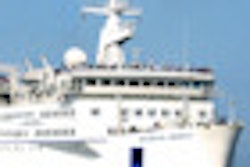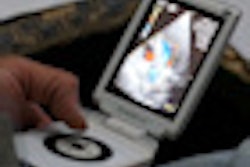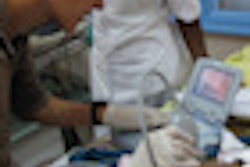
In the mountains of the Achham district in rural Nepal, a five-room, four-bed medical clinic bustles on the spot where once only the wind whistled through an old grain shed. In this remote location, high-tech medical imaging technology combined with satellite telecommunications is improving the quality of healthcare to residents previously without access to doctors.
Since August 2008, Nyaya Health, comprising an outpatient department, maternity ward, emergency room, pharmacy, and laboratory, has served 100 patients a day in a population of 250,000. In addition to providing basic medical care, ultrasound images acquired at the facility are beamed via satellite to Yale University in New Haven, CT, where they are reviewed at the institution's Section of Emergency Medicine.
Providing access to quality medical imaging is a key part of the project, according to Duncan Smith-Rohrberg Maru, Ph.D., a member of the Yale School of Medicine Medical Scientist Training Program and co-founder of Nyaya Health.
"Diagnostic radiology is a major growth industry worldwide, but it's not accessible at all to most of world's poor," Maru said. "There are estimates that over 50% of the world lacks access to any form of x-ray, and even fewer have access to ultrasound. In the region surrounding Achham, for example, there is only one functioning x-ray for over 1 million people."
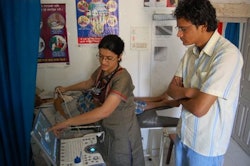 |
| Dr. Tanya Shah discusses ultrasound findings with Nyaya Health assistant Lal Kunwar. Nyaya Health's staff is all Nepali; its administration is volunteer. All images courtesy of Nyaya Health. |
"If we have a patient presenting with abdominal pain and not aware that she had been pregnant, if you missed a diagnosis of stillbirth the woman would be on the verge of sepsis," Maru said. "You might just pick up a positive pregnancy test, but you don't hear a fetal heart rate. Without ultrasound, you're stuck in a rural setting like that. With ultrasound, you can diagnose that very easily. We're training the midwives to do this. They've never seen a computer before, but now they can pick up that there was a miscarriage."
No ionizing radiation, many applications
The Nyaya project revolves around a portable scanner (Logiq e, GE Healthcare, Chalfont St. Giles, U.K.) that's packed with four probes in a rugged carrying case. The system is a good fit for use in a rugged, rural environment such as Achham, according to Maru.
Although maternal care offers the best diagnostic yield for ultrasound, other clinical applications include evaluation of trauma, long-bone fractures, pericardial and pleural effusions, organomegaly, kidney disease, tuberculosis, and gallstones.
"It's somewhat of a nonintuitive point that ultrasound is quite versatile, portable, can be in the hands of a practitioner, and offers immediate point-of-care results," he said.
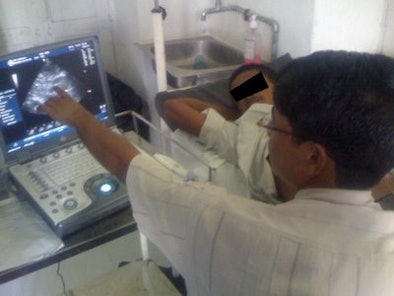 |
| The clinic has quickly become proficient with ultrasound. Here, in a 28-year-old man with right renal colic pain, ultrasound showed grade 1 hydronephrosis. |
Images are transmitted to Yale using a very small aperture terminal (VSAT)-type disk that communicates via satellite both with Kathmandu and Yale. The alternative is to perform an analog-based x-ray and transport the films to Kathmandu for interpretation -- 30 hours by jeep.
Nyaya Health's current obstetric ultrasound protocol is basic, with a simplistic estimation of gestational age by U.S. standards: measuring biparietal diameter, femoral length, and abdominal girth.
"It's definitely an area where our physician is still honing his skills -- his operator margin of error is greater than in the U.S.," Maru noted.
However, the Nepali doctor has help from the Yale emergency medicine department, which receives the ultrasound log database, images, and DVDs of ultrasound clips on a regular basis. Feedback on ultrasound use is also viewable on Nyaya's Web site, where a Yale reviewer's comment on an inadequate study reads, "use curvilinear probe. date fetus. show fetal heart. show landmarks of vaginal stripe, bladder, uterus," and an adequate one is praised with "great image of gallbladder. Good study. Agree."
Gathering data
In fact, data acquisition is almost as important as image acquisition at Nyaya. Maru has a background as an epidemiologist, and the soon-to-be Harvard resident is trying to quantify in as simple a manner as possible the benefits of Nyaya's ultrasound usage.
Statistics on the project's impact are just a click away, thanks to Nyaya Health's commitment to organizational transparency. In its most recent online report, ultrasound examination changed the management of 23% of 70 obstetric cases and 40% of nonobstetric cases.
"The 'changed management' tracking is a semisubjective assessment on the part of the sonographer. In the case of the routine antenatal ultrasound, it may be only 20%, but I wouldn't say that number is too low. In the U.S., the standard of care is to use ultrasound extensively," said Maru. "A good analogy would be if you think of the value of an EKG in someone with chest pain or arm pain. If 2% of those people are in the middle of a heart attack, in those 2% it was critical that you did the EKG. In ultrasound you do a ton of normal scans and then you come across something abnormal."
Expanding: More space, more scans
As Nyaya grows in scope, it hopes to expand its imaging repertoire as well. With recent approval from the Nepal Ministry of Health and Population to renovate an abandoned hospital in Bayalpata, Achham, the clinic has received quotes for a subsidized or donated machine from several manufacturers of digital WHIS-Rad (World Health Imaging System for Radiology) machines, including GE; Philips Healthcare of Andover, MA; and Sedecal of Madrid. WHIS-Rad systems are developed by imaging companies to World Health Organization (WHO) standards and are designed for simple operation in rugged environments.
 |
| Nyaya Health recently acquired Bayalpata Hospital from the Ministry of Health and Population. The hospital is situated an hour's walk from the existing clinic. Renovations will include the installation of a digital x-ray machine. |
Vanden Brink finds Nyaya's telecommunications model, linking image acquisition at a remote site with expert image interpretation and guidance from a luminary site in the developed world, to be an intriguing development. The WHIA is piloting a similar project in Guatemala.
As Nyaya volunteers scout for ways to pay for a $60,000 WHIS-Rad machine and manage construction on the hospital that will house it, Maru is making sure the project's story is heard by radiologists -- who, ironically, have yet to be involved in this diagnostic imaging success story.
"The first step is demonstrating that radiology works in this context. Now we are actively looking for funding mechanisms for global radiology -- private philanthropists, corporations -- to make this feasible on a larger scale," he said.
By Alexandra Weber Morales
AuntMinnie.com contributing writer
June 25, 2009
Related Reading
SIIM aligns with WHIA to expand imaging worldwide, June 5, 2009
Digital technology sparks revival of global x-ray project, April 15, 2009
World Health Imaging launches global mission, April 6, 2009
In a spirit of giving: Medical donations make a difference, November 21, 2006
All hands on deck: How radiological staff can help on hospital ships, November 21, 2006
Copyright © 2009 AuntMinnie.com





